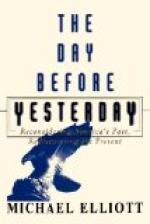My own experiences as a pedagogue are limited. During the War, I was asked to give some lessons in elementary history and rudimentary French to convalescent soldiers in a big hospital. No one ever had a more cheery and good-tempered lot of pupils than I had in my blue-clad, red-tied disciples. For remembering the order of the Kings of England, we used Mr. Chittenden’s jingle, beginning:
“Billy, Billy, Harry,
Ste,
Harry, Dick, Jack, Harry Three.”
By repeating it all together, over and over again, the very jangle of it made it stick in my pupils’ memory. Dates proved a great difficulty, yet a few dates, such as that of the Norman Conquest and of the Battle of Waterloo, were essential. “Clarke, can you remember the date of the Norman Conquest?” “Very sorry, sir; clean gone out of my ’ead.” “Now, Daniels, how about the date of Waterloo?” “You’ve got me this time, sir.” Then I had an inspiration. Feigning to take up a telephone-receiver, and to speak down it, I begged for “Willconk, One, O, double-six, please.” Twenty blithesome wounded Tommies at once went through an elaborate pantomime of unhooking receivers, and asked anxiously for “Willconk—One, O, double-six, miss, please. No, miss, I didn’t say, ‘City, six, eight, five, four’; I said ’Willconk, One, O, double-six.’ Thank you, miss; now I can let mother know I’m coming to tea.” This, accompanied by much playful badinage with the imaginary operator, proved immensely popular, but “Willconk, One, O, double-six” stuck in the brains of my blue-clothed flock. In the same way the Battle of Waterloo became “Batterloo—One, eight, one, five, please, miss,” so both those dates remained in their heads.
We experienced some little trouble in mastering the French numerals, until I tried a new scheme, and called out, “From the right, number, in French!” Then my merry convalescents began shouting gleefully, “Oon,” “Doo,” “Troy,” “Catta,” “Sink,” etc.; but the French numerals stuck in their heads. Never did any one, I imagine, have such a set of jolly, cheery boys in blue as pupils, and the strong remnant of the child left in many of them made them the more attractive.
When I first went to school, the selection and purchase of my outfit was, for some inscrutable reason, left to my sisters’ governess, an elderly lady to whom I was quite devoted. This excellent person, though, knew very little about boys, and nothing whatever as to their requirements. Her mind harked back to the “thirties” and “forties,” and she endeavoured to reconstitute the dress of little boys at that period. She ordered for me a velvet tunic for Sunday wear, of the sort seen in old prints, and a velvet cap with a peak and tassel, such as young England wore in William IV.’s days. She had large, floppy, limp collars specially made for me, of the pattern worn by boys in her youth; every single article of my unfortunate equipment had been obsolete for at least thirty years. In my ignorance, and luckily not knowing what was in store for me, I felt immensely proud of my new kit.




